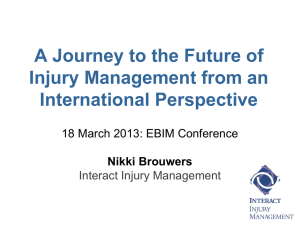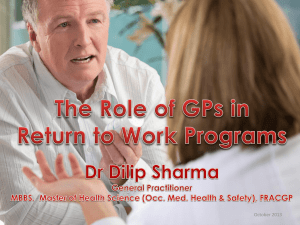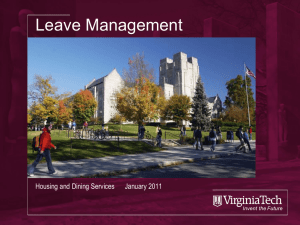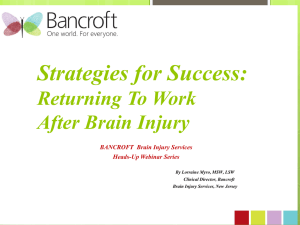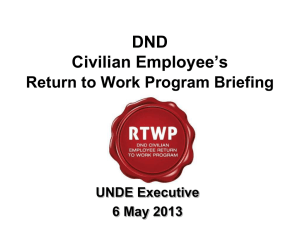Early sick leave - Fit for Work Europe
advertisement
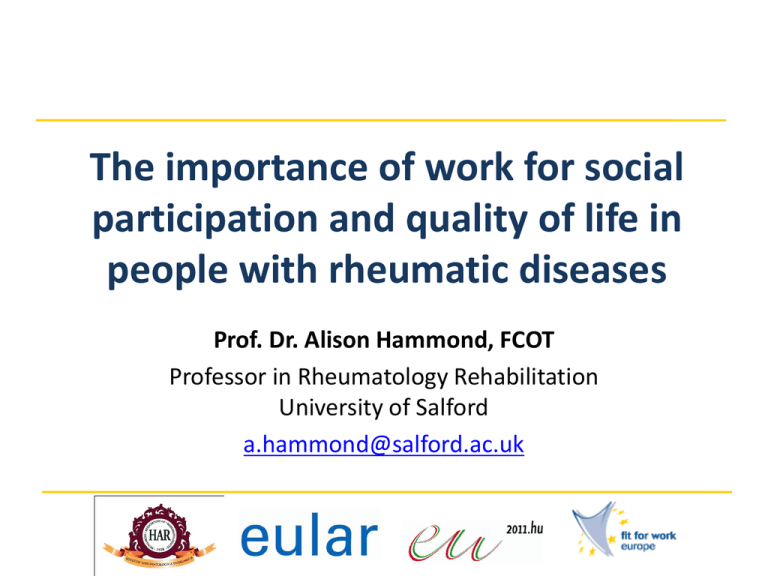
The importance of work for social participation and quality of life in people with rheumatic diseases Prof. Dr. Alison Hammond, FCOT Professor in Rheumatology Rehabilitation University of Salford a.hammond@salford.ac.uk Introduction 1. The problems faced by people with RMDs • staying at work (SAW) or • returning to work (RTW). 2. The effectiveness and benefits of early rehabilitation to enable SAW or early RTW 3. Future developments to improve work participation and quality of life for people with RMDs Work disability and sick leave 40-45%: rheumatoid arthritis (5 y ) 18 –26% ankylosing spondylitis 19-23% systemic lupus 17-33% psoriatic arthritis 34% systemic sclerosis Sick leave in early RA range = 7-84 days/y 24% of work is impaired (presenteeism) Newhall-Perry et al 2000; Merkesdal et al 2001; Verstappen et al 2004; Burton et al 2006; Al-Dhahani et al 2009; Baker et al 2009; Wallenius et al 2009; Vliet Vlieland et al 2009; Ariza-Ariza et al 2009; Rohekar & Pope 2010; Zhang et al 2010) Physical, work and knowledge barriers Fatigue (esp. RA) Pain; Physical limitations: hand function (eg using a computer/ writing), moving quickly, standing, lifting, bending, higher work speed) Work-life balance: reduced leisure activities/ADL Low job autonomy Unadapted work environments, transport difficulties Asking for and obtaining ergonomic modifications/ job accommodations (lack of knowledge and/ or advocacy skills) Qualitative: Mancuso 2000; Backman 2004; Allaire 2007; Lacaille 2007 Quantitative: Proctor et al, 2000; Allaire et al, 2001 ; Teasell et al, 2001; De Buck et al, 2002; Tubach et al, 2002; Verstappen et al, 2004; Lacaille et al, 2004; Yelin, 2004; Manek et al, 2005; Eberhardt et al, 2007. Psychosocial barriers Unwilling to disclose arthritis Reluctance & emotional barriers Increasing role overload Dealing with others responses Guilt Future worries: employment and finances Higher perceived job strain Loss of work self-efficacy Qualitative: Gignac 2006; Lacaille, 2007; Allaire 2007 Quantitative: Proctor et al, 2000; Allaire et al, 2001 ; Teasell et al, 2001; De Buck et al, 2002; Tubach et al, 2002; Verstappen et al, 2004; Lacaille et al, 2004; Yelin, 2004; Manek et al, 2005; Eberhardt et al, 2007. Increasing risk… extended periods of sick leave longer duration of unemployment. Survey: n =300; RA 4 y. 56% work disabled only 18% of these willing to work again (Verstappen et al, 2005) References for predictive factors: Proctor et al, 2000; Allaire et al, 2001 ; Teasell et al, 2001; De Buck et al, 2002; Tubach et al, 2002; Verstappen et al, 2004; Lacaille et al, 2004; Yelin, 2004; Manek et al, 2005; Eberhardt et al, 2007. Reducing risk… Ergonomic modifications to workplace: 2.5 x less likely to stop work Greater use of coping strategies (physical / psychological) to self manage arthritis Support from family/ co-workers (Lacaille, 2004: survey n = 581) Supportive management Effective communication : need for job accommodations and how to change work habits (Shaw et al, 2007) Vocational Rehabilitation “A process to overcome the barriers an individual faces when accessing, remaining or returning to work following injury, illness or impairment.” (DWP, 2004) Assessment of needs/ barriers Work site assessment SAW Ergonomic modifications/job accommodations Support & communication: individual, employer, others (eg family, co-workers); Self-advocacy skills training; Disability awareness training Condition management (physical, psychological); Medical treatment; Staged return to work management by employers. DWP, 2004; Allaire et al, 2007. Career exploration / counselling; Job finding skills training; Job placements/ retraining. RTW Ergonomic modifications… Mini keyboard: half size keys require less effort Built in touch pad to reduce arm movement Voice activated software Ergonomic chair Flex Desk Battery operated hand held letter opener Evidence for early work rehabilitation SAW: Rehabilitation services Job retention intervention: (Macedo et al 2007: UK): o RCT (n=28); o employed RA o usual care v o comprehensive Occupational Therapy for functional, psychological and hand problems o work site assessment, ergonomic modifications, disability rights advice o liaison employer, Access to Work (work adaptations) 6m: Significant reduction work instability, improved work satisfaction, pain, disability; No differences days missed work Too small /short to identify changes in work status SAW: Rehabilitation services Job retention intervention (Allaire et al 2003: USA): All employed (not on sick leave, “concerns re SAW”) RCT (n = 242; 58% RA; OA, SLE, PA, AS); average HAQ 0.54. VR counsellor 2x 1.5 hrs; Optional work visit and employer liaison. Structured interview needs/ barriers; computing, travel, access, work hours; psychological aspects; job accommodation plan. Disability rights; disclosing and requesting job accommodations. Career advice. 3.5 yrs: 49% fewer job losses; high levels satisfaction Need for convenient services or clients delay accessing service SAW early sick leave: MDT interventions Job retention intervention (Abasolo et al 2005, 2007: Spain) Patients with RMDs/MSDs on sick leave RCT n = n=13,077; (inflammatory: n = 187; OA n=258) Intervention: Level 1: Medical assessment; drug management; condition education; self-management education (avoid rest, exercise, ergonomic care, increase physical activity) Level 2: (no improvement 2-6w): referral to rehabilitation, further investigations as necessary Negotiated RTW 12m: reduction in sick leave: OA = 45.4 days; Inflammatory arthritis = 35.4 days Cost-effective SAW – early sick leave: disability employment services RCT postal information on RTW support available (Fleten et al, 2006: Norway) n= 990 (inc. n=99 with RMDs) Letter 2w+ sick leave: brief information work measure available: RTW adjusted job + benefits RTW: co-operation employee, employer and NIO modified work measures At 12m: Sick leave reduced 8 days overall In RMD sub-group: 68 days SAW/RTW: MDT interventions Job retention intervention: (De Buck et al 2005: NL) Mix extended sick leave, employed RCT (n = 140 RA): NL medical assessment Rheumatologist Occupational health doctor liaison Vocational assessment and advice (finances, job accommodations) Rehab: OT, PT, counselling as appropriate Average 6 hours contact. No difference in job retention/ RTW at 2 years. Improved mental health, less fatigue ?? Due to 40% already on extended sick leave – too late? Good disability benefits system in NL Summary of studies 1. Early intervention more effective: o In work: with work instability o Early stages of sick leave o Conveniently timed and located 2. Longer delay, more difficult to SAW/RTW. 3. VR and MDT interventions effective. What more can be done? 1. In work: Brief interventions : Early screening: risk of work instability. Enable: Work self-management education: exercise, pacing, ergonomic modifications to work tasks), Work assessment & advice: simple work and environment modifications (equipment, flexible hours, adaptations, access) Employment rights education Open communication employee and employer What more can be done? 2. Early sick leave: Advice and intervention early (eg by 2 weeks) Assess for needs Stepped care: Medical management (eg drug therapy) Condition and self-management education, work assessment and advice Work rehabilitation and therapy (Occupational therapy, physiotherapy, cognitive-behavioural therapy) as necessary Future research RCTs: Do effective interventions developed in the USA, Spain and Norway, reduce sick leave and improve job retention in other countries with different socioeconomic conditions and employment benefits/ regulations/law? What is their impact on health, participation, quality of work and quality of life? Observational studies and RCTs: effectiveness of current VR services? Are they cost-effective? What are the most effective ways of delivering interventions in practice? Thank you Please Contact Prof. Dr Alison Hammond, Professor in Rheumatology Rehabilitation, University of Salford School of Health, Sport and Rehabilitation Sciences C407 Allerton Building Frederick Road Salford M6 6PU United Kingdom a.hammond@salford.ac.uk

